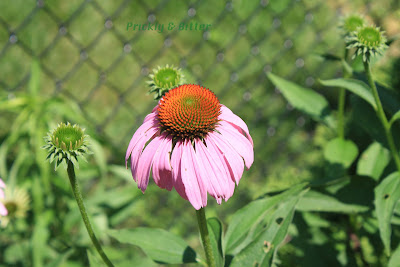Monday, July 23, 2012
Can this prevent you from catching a cold?
Species name: Echinacea purpurea
Common name: purple coneflower
Location: Ontario
Since I spent so many days blogging about non-native daylilies, I figured I should start off the week on a good note by blogging about a native flower that is incredibly attractive in gardens and a good plant to use in gardens to attract bees, butterflies and moths: the purple coneflower. Interestingly enough, this plant is becoming less and less common in the wild due to land-use change, and potentially a changing climate. It thrives in dry areas in meadows or open woods, and is incredibly drought-tolerant once established. While not truly "deer-safe," once the stand of plants has established itself it is rarely consumed by large herbivores because of its prickly leaves and unpalatable, spiky flowers.
As many of you can probably guess from the name, this is a very popular medicinal plant. Historically, it was used very commonly in traditional native medicine in North America and has since crossed over into "main stream herbal medicine." People believe it has strong immune system boosting properties, and a couple of poorly-conducted studies have shown it has some effect on depression and L-DOPA (a potential treatment for Parkinson's). Unfortunately, none of these claims have been backed up by strong, repeatable scientific studies so the "true" medicinal effects of this plant should always be taken with a grain of salt. Taking an Echinacea pill or drinking Echinacea tea if you have a cold certainly won't harm you, but don't count on it making you better, either. Doesn't taste too bad with a bit of honey and lemon, and grows pretty commonly in gardens around the neighbourhood so it's a cheap treatment to try. Even the placebo effect alone might be enough to cure you of your cold!
The side effects of using this plant medicinally are incredibly rare, and usually include temporary rash or other form of skin irritation. There are a couple of documented cases of this plant causing a near-death allergic reaction, but these people also reported being allergic to sunflower seeds (so being allergic to this plant, too, shouldn't come as that big a surprise; they're in the same family). A word of caution regarding all plants that look like sunflowers or coneflowers: if you're using them medicinally or for food, make sure you know what kind of soil you're growing them in. Plants in the aster or sunflower family are referred to as "hyper-accumulators" of various toxic compounds including lead, cadmium, uranium, and copper, all of which can be toxic (copper is a compound required in trace amounts by our body for basic survival; in amounts too high toxicity and death can occur). Make sure if you "source" your Echinacea from a location other than your garden you know the history of the property (and the soil) to know if you should be concerned about heavy metal accumulation in the plant tissues.
Subscribe to:
Post Comments (Atom)




No comments:
Post a Comment